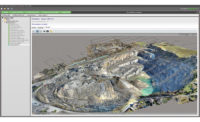Every time a driver hits the road, Big Data comes along for the ride, hitchhiking on cell phones, location-based apps and vehicle hardware. The resulting data stream has changed how many urban planners, engineers and contractors analyze traffic patterns to plan transportation projects.
The entry of Big Data into the field of mobility analytics has created a road map for technology companies eager to help engineering firms create traffic models with more precision. Such models can detail drivers’ origins, destinations and trip routes during specific times, says Michael Iswalt, associate of transportation planning at Arup. “This kind of data shows you—empirically—what people are doing. It takes a lot of guesswork out of what traffic engineering tends to be.”
More companies have entered the space, each one offering its own approach to capturing, analyzing and presenting the data. San Francisco-based StreetLight Data gathers both “location-based” and GPS-navigation data. AirSage in Atlanta signs contracts with carriers. Dutch company TomTom just teamed up with Cisco to use its sensors. Transit agencies collect bus data and offer it for free online.
Arup began using Big Data for traffic models in 2014, when it hired StreetLight to analyze traffic around the $4-billion rebuild of the Tappan Zee Bridge over the Hudson River. “We were building a pretty large microsimulation model of a New York freeway across a bridge between two counties,” Iswalt says. “Most travel data surveys and counters weren’t giving that kind of detail. We needed smaller zones, matching on-ramps and off-ramps at different times of day.”
Founded in 2011, StreetLight gathers much of its data from location-based “backgrounding” apps that provide services such as weather forecasts and local store coupons. It also uses navigation-GPS data from internet-connected vehicles and trip navigation apps. The company’s business is about evenly split between engineering firms and government entities.
“Five years ago, it was all about the carriers,” says StreetLight CEO Laura Schewel. “It was a seller’s market—you’d go to the carriers and pay for the information. In the past 18 months, that’s changed. The apps come to us and offer their data.”
When the small California city of Lafayette (pop. 24,000) hired Arup to study downtown traffic congestion, the firm focused on commuters, residents and shoppers. But StreetLight’s data revealed another major factor: the flow of through-travelers from a nearby freeway. Using the models, city officials proposed traffic projects such as traffic-signal coordination, extension of freeway ramps and a pedestrian bridge. City engineer Tony Coe found the study useful but considers Big Data more suitable for regional networks across city and county lines.
“Big Data—I think it has its place,” Coe says. “But you are taking on faith that some of the information you are looking at reflects what is going on in the world.”
Companies offering traffic-pattern analysis continue to evolve. Schewel says StreetLight’s data could help to manage traffic during roadwork and measure traffic impacts of completed projects. Iswalt points to advances, such as machine learning, that will allow firms to see relationships between many different data sets.
“There’s a lot of uncertainty in what we do,” Iswalt says. “But the better the data, the better foundation we have to solve problems.”




Post a comment to this article
Report Abusive Comment